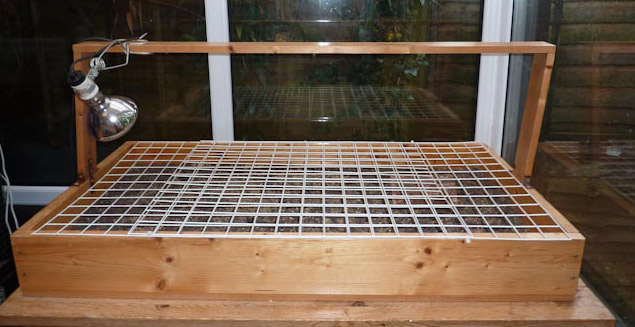
Tortoise Vivarium Reviews and
Tests
Part
Three - Tortoise Table
Part Two
- Geko vivarium
Part
One - Jon Coote Tortoise Starter Kit
Recently we undertook
a very detailed series
of measurements and conducted the most comprehensive tests and
reviews ever carried
out on the different types of indoor habitat available for tortoises.
The third part of
this report is now available, and it discusses our findings on a
typical 'Tortoise Table' type open-topped terrarium. See links above
for earlier reports on other types of vivarium.

A 50 mm deep mixed topsoil and sand substrate was added.
A wooden gantry arrangement to permit the fixture of heating and lighting is all that is required to complete the unit. The total cost of the unit we made for this test was £24.00 (approximately 27 Euros or $38.00), excluding electrical parts which can be selected as required. We chose to install a 160 watt Mega Ray lamp in a ceramic holder for this test as it would be typical of a set-up intended for Mediterranean, Russian or Leopard tortoises.
The overhead lighting support beam offers a high degree of flexibility to install alternate forms of light and heat, however. For example, ceramic heaters can be installed where some overnight heat is required, or a fluorescent tube could be used, or multiple lower wattage lamps fitted, or a combination of various types. Whichever form of heat and light is used, it is important that it is selected to match the requirements of the species being maintained.
This was also the simplest unit to test as there was only one heat source involved and because the overall design and construction of this type of habitat is so basic.
DOWNLOAD THE FULL TEST REPORT HERE
(Adobe PDF Reader 6.0 or above required)
Summary:
- The basking temperatures and temperature gradient available within this type of unit when fitted with a suitable lamp is excellent, and is well within tolerances for all Mediterranean species.
- The range of temperatures available also suit many semi-arid tropical zone species such as Leopard tortoises (Geochelone pardalis), African Spurred tortoises (Geochelone sulcata) and Indian Star tortoises (Geochelone elegans). Some sensitive species may require supplementary overhead heating at the far end of the unit, however, if the unit is located in an otherwise unheated, cool position.
- Careful attention does need to be paid to positioning of open-topped units as they are much more sensitive to room fluctuations than enclosed designs in terms of both temperature and humidity.
- Use of a suitable depth and type of substrate provides a wide range of microclimate choices and contributes to achieving natural behaviour patterns (use of scrapes, partially burying, etc.) This also has important implications for health.
- Provided a high quality lamp is used, excellent UV-B levels can be achieved.
- Self-ballasted mercury vapour lamps of all brands appear to be very prone to temporarily cutting out due to overheating when used in certain reflector-holders. Solutions are to dispense with the reflector or to use externally ballasted models which do not seem to suffer from this problem.
On the basis of these tests, provided they are installed and operated correctly, the open-topped ‘Table’ type design offers a very acceptable and low cost method of housing a wide range of semi-arid habitat tortoises indoors. They are less suitable for high humidity tropical species unless special measures are taken. Suitable models of ‘Tortoise Table’ can be purchased ready made, or home construction from readily available materials is also possible. Of the three designs tested, only the open-topped design produced a safe and satisfactory range of basking temperatures combined with an adequate temperature gradient. Both enclosed designs failed completely. The ‘Tortoise Table’ design was also the only unit to produce the necessary combination of UV-B and radiant heat levels necessary for self-synthesis of vitamin D3 in tortoises.
(c) October 2009 Tortoise Trust